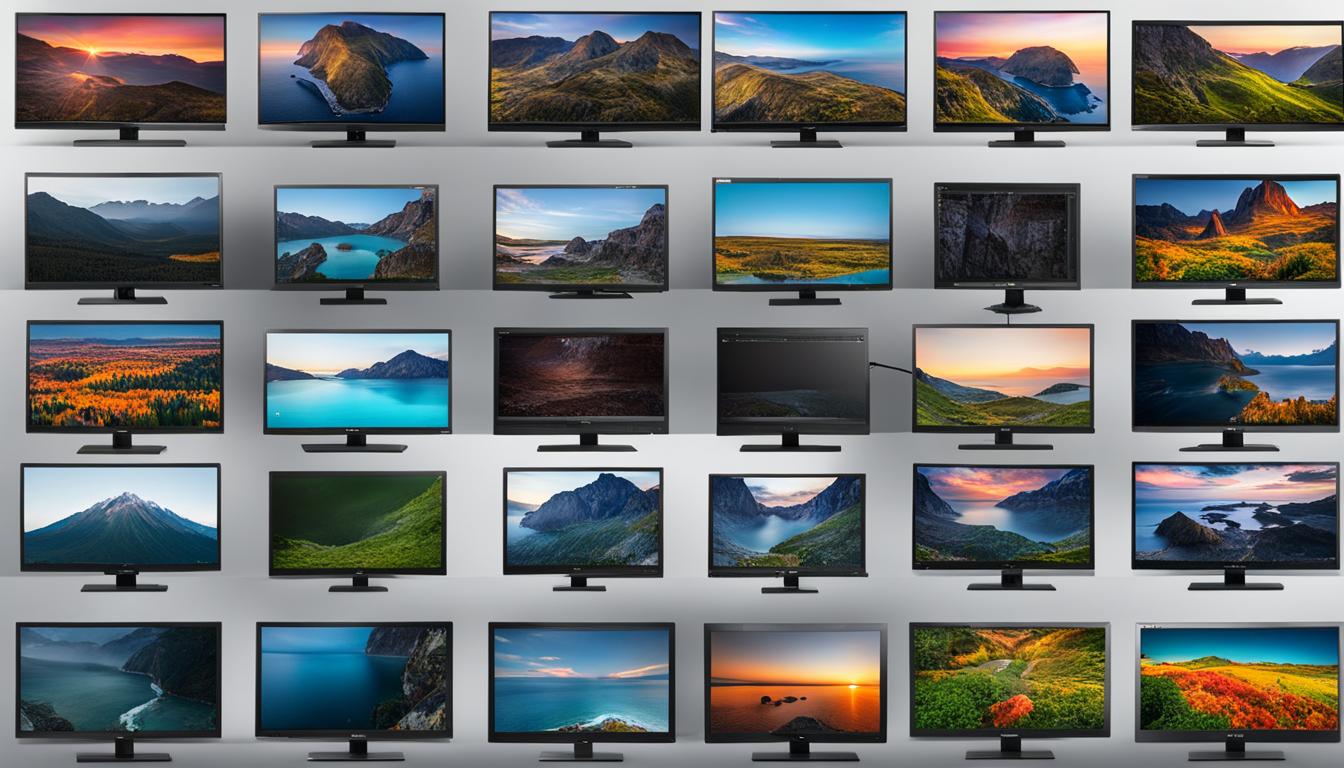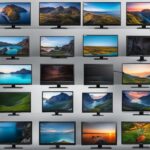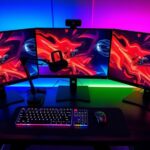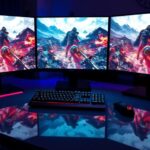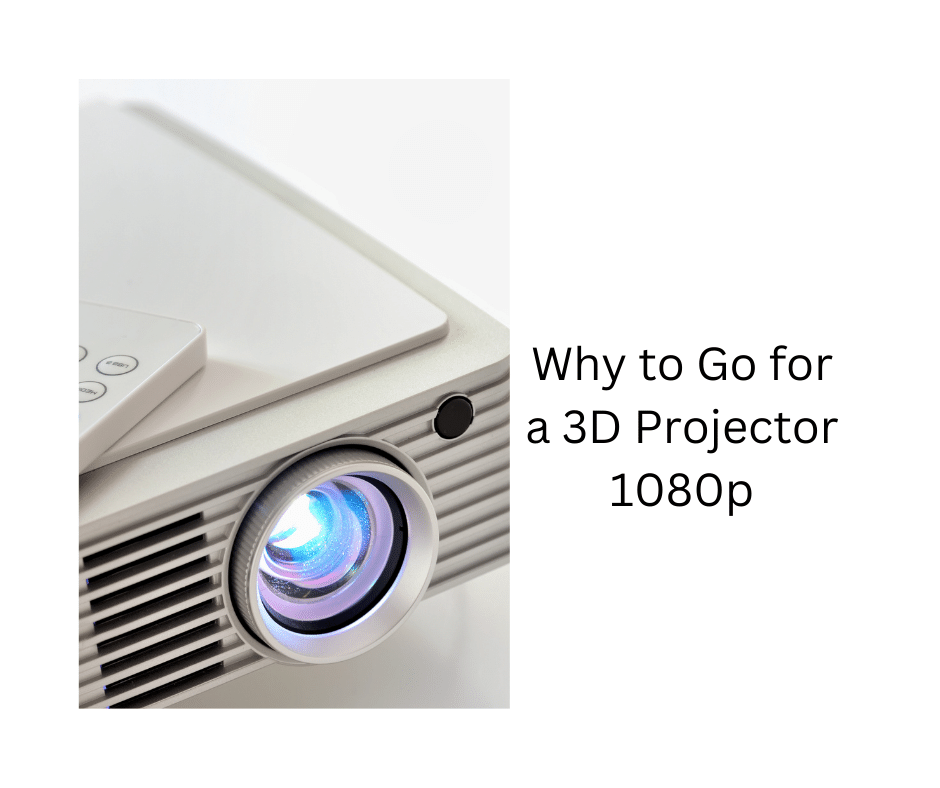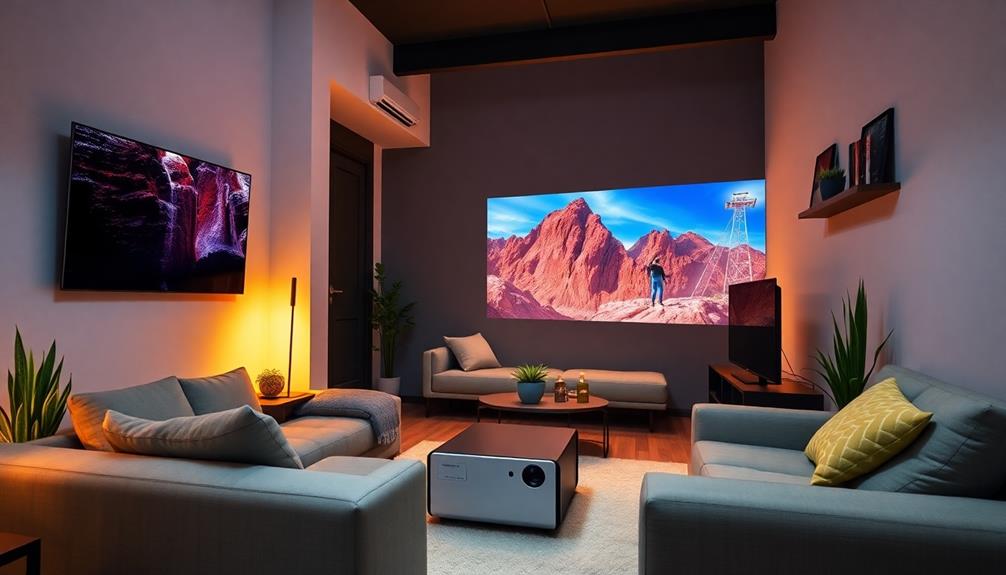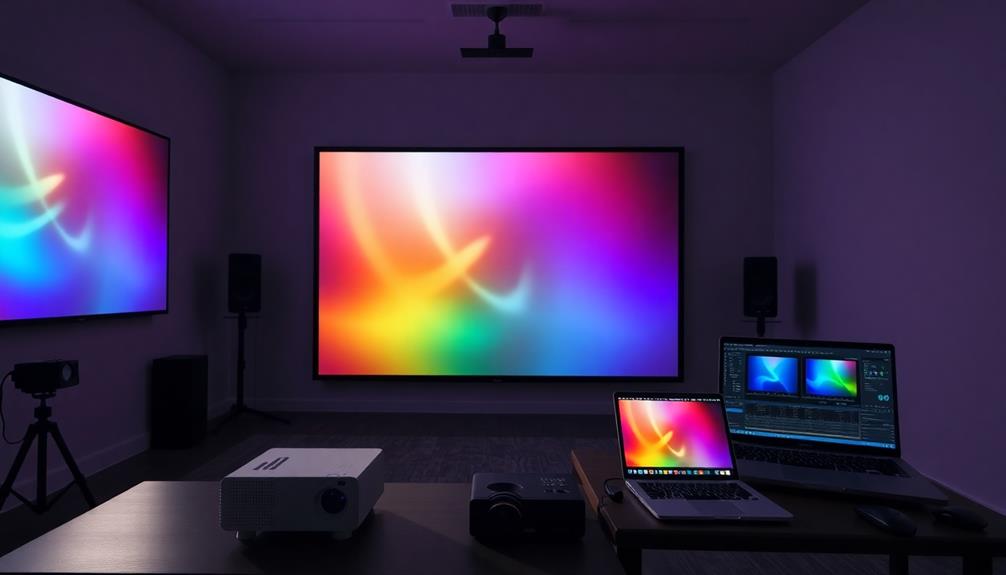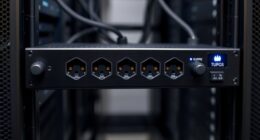Welcome to our comprehensive guide on display connectivity and screen setup. Whether you’re a professional in need of a high-performance monitor or a casual user looking to upgrade your display, understanding the intricacies of display technology is essential for making an informed decision. In this article, we will demystify the differences between LED and LCD monitors, explore how they work, highlight their key advantages, and provide you with valuable insights to help you choose the right monitor for your needs.
Key Takeaways:
- LED monitors use light-emitting diodes as backlight sources, while LCD monitors use cold cathode fluorescent lamps.
- LED monitors offer advantages in energy efficiency and color reproduction, making them ideal for tasks like photo and video editing.
- LCD monitors excel in image sharpness and clarity, are more affordable, and perform well in bright environments.
- Consider factors like specific usage, budget, size and resolution, connectivity options, and manufacturer reputation when choosing between LED and LCD monitors.
- Understanding display specifications and selecting the appropriate monitor cable type are crucial for optimal screen setup.
How LED and LCD Monitors Work
LED and LCD monitors may appear similar at first glance, but their underlying technologies differ in important ways. Understanding how these monitors work is essential for making an informed choice when it comes to your screen setup.
Both LED and LCD monitors utilize liquid crystal technology. This technology involves liquid crystal molecules that rotate or align to control the passage of light through the screen. However, the key difference lies in the backlighting mechanism.
LCD monitors use cold cathode fluorescent lamps (CCFLs) as their backlight source. These lamps emit white light that passes through the liquid crystal layer, resulting in the formation of images on the screen. On the other hand, LED monitors employ light-emitting diodes as backlight sources. These diodes emit light that can be categorized into two types: edge-lit and direct-lit.
Edge-lit LED Monitors
Edge-lit LED monitors position the LEDs around the edges of the screen, allowing the light to diffuse across the entire display. This design allows for slimmer and more lightweight monitors, making them a popular choice for space-conscious users.
Direct-lit LED Monitors
Direct-lit LED monitors, as the name suggests, place the LEDs behind the entire screen uniformly. This setup provides more precise control over the backlighting and enhances the overall picture quality. Direct-lit LED monitors are often preferred by professionals who require accurate color reproduction and consistent brightness levels.
| Feature | LCD Monitors | LED Monitors |
|---|---|---|
| Backlighting Mechanism | Cold Cathode Fluorescent Lamps (CCFLs) | Light-Emitting Diodes (LEDs) |
| Types | N/A | Edge-lit and Direct-lit |
| Advantages | – Affordable price – Excellent image sharpness and clarity – Compatibility with older hardware |
– Energy efficiency – Wide color gamut and accurate color reproduction – Superior contrast ratios – Faster response times |
Knowing how LED and LCD monitors work, as well as their differences in backlighting mechanism, can help you choose the right monitor for your specific needs. Whether you prioritize energy efficiency and vibrant colors or affordability and image sharpness, understanding these technologies empowers you to make an informed decision when it comes to your screen setup.
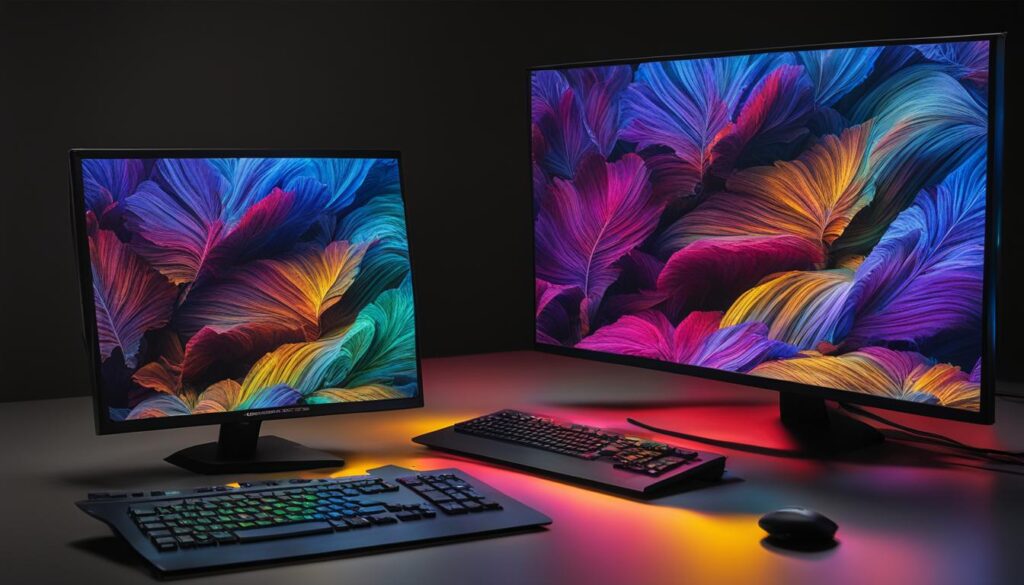
Key Differences Between LED and LCD Monitors
LED and LCD monitors have several key differences that can influence your buying decision. Understanding these differences will help you make an informed choice when selecting a monitor for your needs.
Backlighting Method: One of the main distinctions between LED and LCD monitors is the backlighting method. LED monitors use light-emitting diodes as the backlight source, while LCD monitors use cold cathode fluorescent lamps (CCFLs). LED monitors have an edge in energy efficiency, consuming less power compared to LCD monitors with CCFLs.
Power Consumption: LED monitors are known for their energy efficiency. The use of LEDs as a backlight source allows them to consume less power compared to LCD monitors with CCFLs. This not only reduces energy costs but also contributes to a greener and more environmentally friendly setup.
Color Reproduction and Image Quality: LED monitors typically offer a wider color gamut, allowing for more vibrant and accurate color reproduction. This makes LED monitors ideal for tasks that require precise color representation, such as photo editing and graphic design. On the other hand, LCD monitors excel in image sharpness and clarity, making them well-suited for applications where text readability or detailed visuals are important.
| LED Monitors | LCD Monitors | |
|---|---|---|
| Backlighting Method | Light-emitting diodes (LEDs) | Cold cathode fluorescent lamps (CCFLs) |
| Power Consumption | Lower power consumption | Higher power consumption |
| Color Reproduction | Wider color gamut for vibrant and accurate colors | Standard color gamut |
| Image Quality | Good image quality with a focus on energy efficiency | Excellent image sharpness and clarity |
When choosing between LED and LCD monitors, consider factors such as your specific usage, budget, and desired image quality. LED monitors are ideal for those who prioritize energy efficiency and vibrant color reproduction, while LCD monitors may be a more budget-friendly option with superior image sharpness and clarity. By understanding these key differences, you can select the monitor that best suits your needs and preferences.
Advantages of LED Monitors
LED monitors offer several advantages over LCD monitors. First and foremost, they are highly energy-efficient, consuming less power and leading to lower electricity bills. This makes LED monitors a more environmentally friendly choice, as they contribute to reducing energy consumption.
Another significant advantage of LED monitors is their superior color reproduction. LED technology allows for a wider color gamut, resulting in more accurate and vibrant colors. Whether you’re editing photos, watching movies, or playing games, LED monitors can provide a visually stunning experience with lifelike color representation.
LED monitors also excel in contrast ratio, offering better image depth and detail. The contrast ratio determines the difference between the darkest blacks and the brightest whites on the screen, enhancing the overall visual experience. Additionally, LED monitors have faster response times, meaning they can display fast-moving images with minimal motion blur and ghosting effects. This makes LED monitors particularly suitable for gaming and other dynamic applications.
| Advantages of LED Monitors |
|---|
| Energy Efficiency |
| Superior Color Reproduction |
| Higher Contrast Ratio |
| Faster Response Times |
In summary, LED monitors have numerous advantages, including energy efficiency, superior color reproduction, higher contrast ratio, and faster response times. These features make LED monitors a popular choice for individuals who prioritize energy-saving measures, accurate color representation, and smooth visuals.

Advantages of LCD Monitors
While LED monitors have gained popularity, LCD monitors still have advantages that make them a viable choice. One of the key advantages of LCD monitors is their affordability. They are more budget-friendly compared to LED monitors, making them a cost-effective option for those looking to save money without compromising on quality. So if you’re on a tight budget, LCD monitors can be a great choice.
In addition to affordability, LCD monitors excel in image quality. With their sharpness and clarity, LCD monitors are ideal for tasks that require text readability or detailed visuals. Whether you’re working on design projects, editing documents, or simply enjoying multimedia content, an LCD monitor can deliver crisp and clear images that enhance your overall viewing experience.
LCD monitors also perform well in bright environments. With higher brightness levels compared to LED monitors, they offer improved visibility and readability even when exposed to high ambient light. So if you often work in a well-lit room or under direct sunlight, an LCD monitor can ensure that your display remains vibrant and easy to see.
Another advantage of LCD monitors is their compatibility with older hardware. If you have legacy devices or prefer using older computer systems, LCD monitors provide flexibility in terms of connectivity options. You can easily connect your older devices to an LCD monitor using various ports like VGA or DVI, ensuring a seamless integration with your existing setup.
| Advantages of LCD Monitors | |
|---|---|
| Affordability | More budget-friendly compared to LED monitors |
| Image Quality | Sharper and clearer visuals, ideal for text readability and detailed graphics |
| Brightness | Perform well in bright environments, with higher brightness levels |
| Compatibility | Compatible with older hardware, providing flexibility in connectivity options |

In conclusion, LCD monitors have their own set of advantages that make them a worthy choice in the world of display connectivity. They offer affordability, excellent image quality, enhanced visibility in bright environments, and compatibility with older hardware. Consider these factors and your specific needs when making a decision and create an optimal screen setup that suits you best.
Factors to Consider When Choosing Between LED and LCD Monitors
When deciding between LED and LCD monitors, there are several important factors to consider. These factors will help you determine which type of monitor is the best fit for your specific usage, budget, size and resolution preferences, connectivity options, and the reputation of the manufacturer.
First, consider your specific usage requirements. Different applications may have varying demands for color accuracy, response times, and resolution. If you are using the monitor for tasks like photo and video editing, where color accuracy is crucial, LED monitors may be the better choice due to their wider color gamut. On the other hand, if you require sharp image quality and text readability, LCD monitors excel in these areas.
Budget is another important consideration. LED monitors tend to be more expensive compared to LCD monitors. If budget is a constraint, LCD monitors offer a more affordable option without compromising on image quality and performance.
Size and resolution are also significant factors. Consider the available desk space and the desired level of detail when choosing the monitor size and resolution. LED and LCD monitors come in various sizes and resolutions, ensuring you can find the perfect fit for your needs.
Connectivity options
Furthermore, it is essential to evaluate the connectivity options of both LED and LCD monitors. Consider the devices you will be connecting to the monitor and ensure compatibility with the available ports. LED and LCD monitors typically come with HDMI, DisplayPort, and VGA ports, among others. Assessing the connectivity options will guarantee a seamless connection to your devices.
Finally, take into account the reputation of the manufacturer. Look for manufacturers with a good track record in terms of product quality and customer support. Opting for a reputable brand can give you peace of mind knowing that you are investing in a reliable and durable monitor.
By considering these factors, you can make an informed decision when choosing between LED and LCD monitors. Whether you prioritize color accuracy, energy efficiency, affordability, or connectivity options, evaluating these aspects will help you find the perfect monitor for your needs.
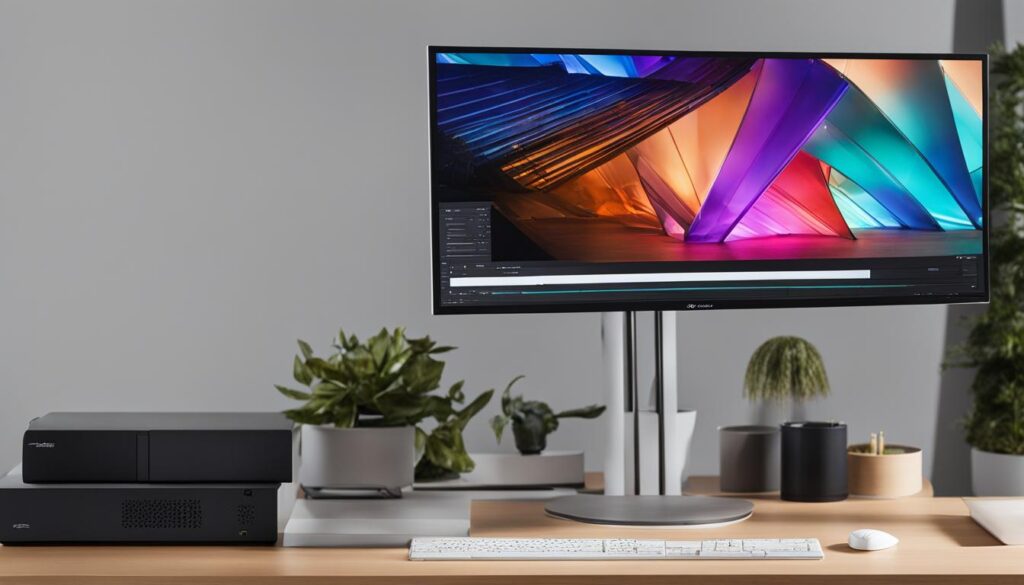
Table: LED vs. LCD Monitors Comparison
| Factors | LED Monitors | LCD Monitors |
|---|---|---|
| Backlighting | Uses light-emitting diodes (LEDs) as backlight sources | Uses cold cathode fluorescent lamps (CCFLs) for backlighting |
| Power Consumption | Lower power consumption compared to LCD monitors | Higher power consumption compared to LED monitors |
| Color Reproduction | Wider color gamut, offering more accurate and vibrant color representation | Slightly narrower color gamut compared to LED monitors |
| Image Quality | Slightly better in terms of contrast ratio and response times | Sharper image quality and clarity |
| Affordability | Tend to be more expensive compared to LCD monitors | More affordable option |
| Compatibility | Compatible with modern hardware and connectivity options | Compatible with older hardware and connectivity options |
Understanding Display Specifications: Resolution, Refresh Rate, Response Time, Contrast, and Color Gamut
When choosing a monitor, it’s important to understand the various display specifications that impact image quality and performance. Here, we’ll explore the key specifications to consider: resolution, refresh rate, response time, contrast ratio, and color gamut.
Resolution
Resolution refers to the number of pixels on a screen, determining the level of detail and sharpness. Common resolutions include Full HD (1920×1080), Quad HD (2560×1440), and 4K Ultra HD (3840×2160). Higher resolutions offer greater detail but require more powerful hardware to run smoothly.
Refresh Rate
The refresh rate is the number of times the screen refreshes per second. It is measured in Hertz (Hz) and determines the smoothness of motion on the screen. Higher refresh rates, such as 144Hz or 240Hz, result in smoother visuals, reducing motion blur and providing a more immersive experience for gaming or fast-paced tasks.
Response Time
Response time refers to how quickly pixels can change from one color to another. It is measured in milliseconds (ms). A lower response time, such as 1ms or 4ms, means faster pixel transitions and less blurring or ghosting in fast-moving images. This is important for activities like gaming or watching action-packed videos.
Contrast Ratio
Contrast ratio measures the difference between the darkest blacks and the brightest whites a display can produce. A higher contrast ratio provides more visual depth and enhances the distinction between colors. This is particularly important for tasks that require accurate color representation, such as photo editing or graphic design.
Color Gamut
Color gamut refers to the range of colors a display can reproduce. It is typically expressed as a percentage of the color space, such as sRGB or Adobe RGB. A wider color gamut allows for more vibrant and accurate color representation. This is beneficial for tasks like video editing, where color accuracy is essential.
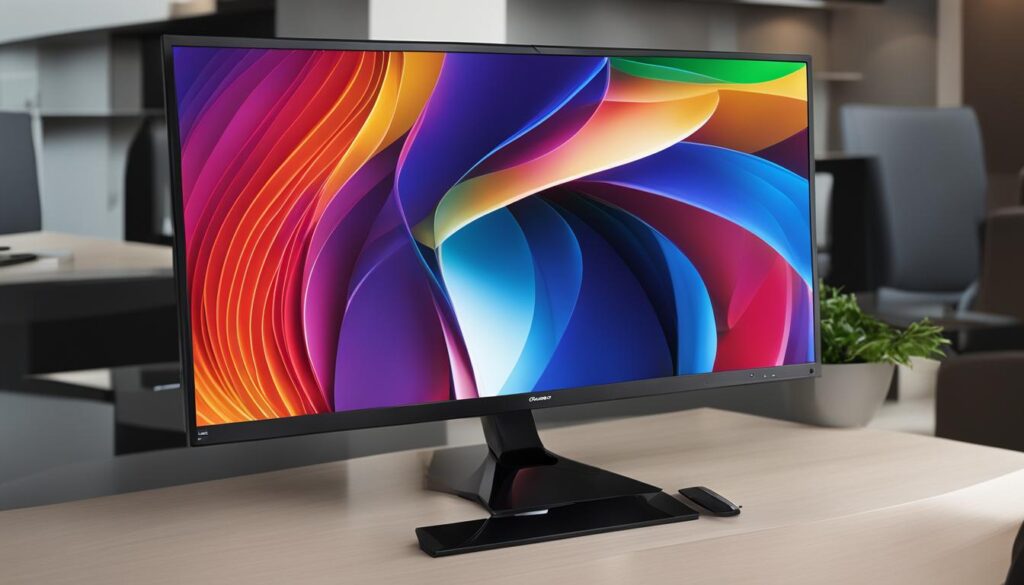
Understanding these display specifications will help you make an informed decision when choosing a monitor that meets your specific needs. Whether you prioritize high resolution for detailed visuals, a high refresh rate for smooth motion, or accurate color reproduction, considering these specifications will ensure you find the right monitor for your requirements.
The Fascinating World of Monitor Cable Types
When it comes to connecting your display devices to video sources, the world of monitor cable types can be quite fascinating. Each cable type has its own characteristics and uses, making it important to choose the right one for your specific needs. Let’s explore the three main types of monitor cables: VGA, DVI, and HDMI.
VGA Cable
The VGA (Video Graphics Array) cable has been a long-standing standard for connecting monitors to PCs and laptops. It is an analog cable that carries video signals. While VGA cables have been widely used in the past, they are slowly being replaced by digital alternatives due to their limitations in delivering high-definition video and audio signals.
DVI Cable
The DVI (Digital Visual Interface) cable offers both analog and digital transmission capabilities. It provides a high-quality digital connection between your monitor and video source, ensuring sharp and clear visuals. DVI cables are commonly used for connecting monitors to PCs, gaming consoles, and DVD players. If your monitor and video source support DVI, it is a great choice for achieving superior image quality.
HDMI Cable
The HDMI (High-Definition Multimedia Interface) cable is one of the most versatile monitor cable types available today. It carries both high-definition video and audio signals in a single cable, eliminating the need for separate audio connections. HDMI cables are commonly used for connecting modern devices like gaming consoles, Blu-ray players, and set-top boxes to HD monitors or TVs. With their ability to deliver superior audio and video quality, HDMI cables have become the go-to choice for many users.
| Cable Type | Advantages | Disadvantages |
|---|---|---|
| VGA | – Wide compatibility – Analog transmission – Cost-effective |
– Limited resolution support – No audio transmission |
| DVI | – High-quality digital connection – Sharp and clear visuals – Analog and digital compatibility |
– No audio transmission – Limited support for newer devices |
| HDMI | – High-definition video and audio transmission – Easy plug-and-play setup – Wide compatibility |
– More expensive compared to VGA and DVI cables |
Each monitor cable type has its own strengths and limitations, so it’s important to choose the one that suits your specific needs. Whether you’re looking for wide compatibility, high-quality digital transmission, or a versatile solution for both video and audio, there’s a monitor cable type that’s perfect for you.
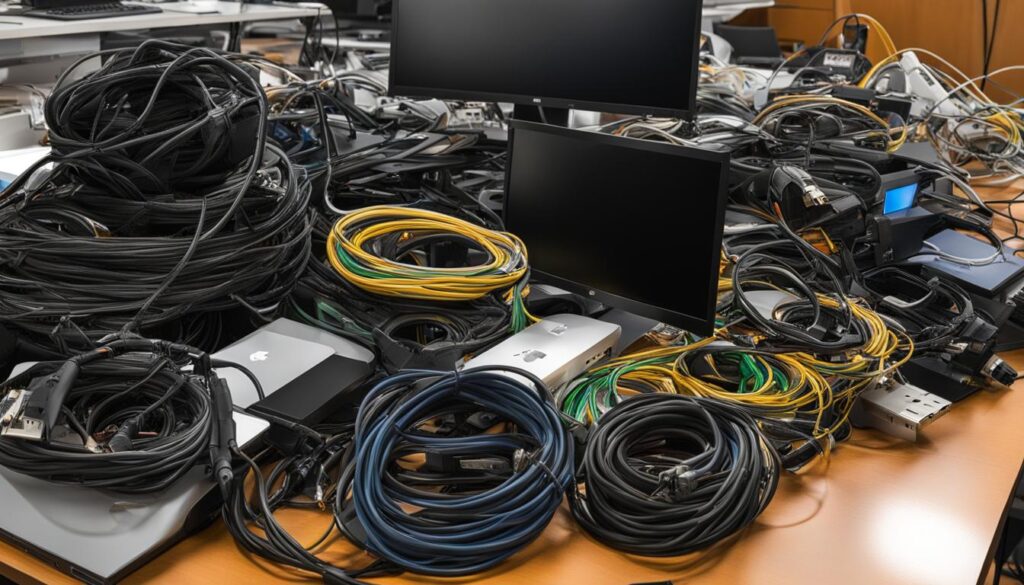
Conclusion
Creating an optimal screen setup begins with understanding display connectivity and choosing the right monitor. LED and LCD monitors have distinct differences in backlighting, power consumption, color reproduction, and image quality. LED monitors offer energy efficiency, vibrant color representation, superior contrast ratios, and faster response times, making them ideal for tasks like photo editing and gaming.
On the other hand, LCD monitors provide affordability, sharp image quality, compatibility with older hardware, and better performance in bright environments. These monitors are well-suited for tasks that require text readability or detailed visuals. When making a decision, consider factors such as specific usage, budget, size and resolution, connectivity options, and manufacturer reputation.
Additionally, understanding display specifications like resolution, refresh rate, response time, contrast ratio, and color gamut is crucial. These specifications determine the level of detail, motion smoothness, blurring effects, visual depth, and color reproduction of a monitor. By selecting the appropriate monitor cable type, such as VGA, DVI, or HDMI, you can ensure optimal connectivity between your display and video sources.
In conclusion, by taking into account all these factors and understanding the differences between LED and LCD monitors, you can create an optimal screen setup that meets your specific needs. Whether you prioritize energy efficiency, vibrant colors, affordability, or sharp image quality, there’s a monitor out there that will suit you perfectly. So, make an informed decision and enjoy an enhanced viewing experience!
FAQ
What is the difference between LED and LCD monitors?
LED monitors use light-emitting diodes as backlight sources, while LCD monitors use cold cathode fluorescent lamps.
What are the advantages of LED monitors?
LED monitors are energy-efficient, have a wider color gamut, offer superior contrast ratios, and have faster response times.
What are the advantages of LCD monitors?
LCD monitors are more affordable, excel in image quality, perform well in bright environments, and are compatible with older hardware.
What factors should be considered when choosing between LED and LCD monitors?
Specific usage, budget, size and resolution, connectivity options, and manufacturer reputation should be considered.
What are the key specifications to consider when selecting a monitor?
Resolution, refresh rate, response time, contrast ratio, and color gamut are important specifications to consider.
What are the different types of monitor cables?
There are VGA cables, DVI cables, and HDMI cables, each with their own characteristics and uses.
How do I create an optimal screen setup?
Understanding display connectivity, choosing the right monitor, and considering factors such as specific usage and connectivity options are essential.
Source Links
- https://medium.com/@hasonsnik/demystifying-led-and-lcd-monitors-understanding-the-key-differences-e80ac6b3917a
- https://www.xhpanel.com/info-detail/demystifying-display-specifications-a-comprehensive-guide
- https://www.quarktwin.com/blogs/accessory/demystifying-monitor-cable-types-from-vga-to-thunderbolt-and-beyond?id=333

